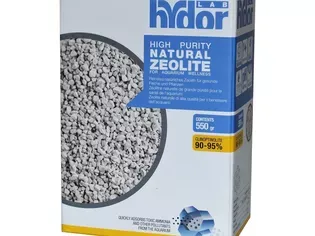When and How to Use Zeolite in Your Aquarium
Updated on 04/26/24

When and How to Harness the Power of Zeolite for Your Thriving Aquarium
Introduction
Zeolite, a fascinating natural mineral, has emerged as a game-changer in the aquarium hobby. Its unique properties offer aquarium enthusiasts a powerful tool to maintain pristine water conditions, promote fish health, and enhance the overall well-being of their aquatic ecosystems. In this comprehensive guide, we will delve into the intricacies of zeolite, exploring its benefits, optimal usage, and practical considerations for incorporating it into your aquarium.
Understanding Zeolite: A Microscopic Marvel
Zeolite is a crystalline mineral composed of hydrated aluminosilicates. Its porous structure, characterized by interconnected channels and cages, resembles a microscopic honeycomb. This intricate network provides zeolite with an extraordinary capacity for ion exchange and adsorption.
Benefits of Zeolite in the Aquarium
The remarkable ion-exchange properties of zeolite make it an invaluable addition to any aquarium. Here are some key benefits:
* Ammonia and Nitrate Removal: Zeolite effectively removes toxic ammonia and nitrate, which are byproducts of fish metabolism and decomposition. By maintaining low levels of these compounds, zeolite helps prevent fish stress, disease outbreaks, and stunted growth.
* Heavy Metal Absorption: Zeolite has a strong affinity for heavy metals, such as copper, lead, and zinc. These metals can accumulate in the aquarium water, posing a threat to aquatic life. Zeolite acts as a filtration system, removing heavy metals and safeguarding the health of your fish.
* pH Buffering: Zeolite exhibits a slight alkaline nature, which can help buffer pH fluctuations in the aquarium. This is particularly beneficial in systems where the pH tends to drop, ensuring a stable and healthy environment for most aquatic species.
* Crystal Clear Water: Zeolite's adsorption properties contribute to crystal-clear water conditions. By removing suspended particles, including organic debris and dissolved impurities, zeolite enhances water clarity, creating a more visually appealing and inviting aquarium.
Optimal Usage of Zeolite
To reap the full benefits of zeolite in your aquarium, it's crucial to use it effectively. Here are some guidelines:
1. Choose the Right Type: Various types of zeolite are available for aquarium use. Clinoptilolite, a specific type of zeolite, is highly recommended due to its exceptional ion-exchange capacity and compatibility with aquatic environments.
2. Determine the Amount: The appropriate amount of zeolite for your aquarium depends on several factors, including tank size, fish population, and water quality. As a general rule of thumb, use about 1 pound (0.5 kg) of zeolite for every 50 gallons of aquarium water.
3. Placement: Zeolite can be placed in various locations within the aquarium. You can add it to the canister filter, hang-on-back filter, or simply place it in a mesh bag and submerge it in the water column.
4. Activation: Before using zeolite in your aquarium, it's essential to activate it. This involves rinsing the zeolite thoroughly with clean water to remove any impurities and fines. Once rinsed, soak the zeolite in a solution of saltwater (1 cup of salt per 5 gallons of water) for 24 hours. Rinse the zeolite again before using it.
5. Maintenance: Zeolite's effectiveness gradually diminishes over time as it absorbs impurities. To maintain its optimal performance, replace the zeolite every 6-12 months, or more frequently if necessary.
Examples of Zeolite Usage in Different Aquarium Settings
To illustrate the practical applications of zeolite in various aquarium setups, here are a few examples:
* Freshwater Aquarium: In freshwater aquariums with high fish populations or limited filtration, zeolite can be used as an effective ammonia and nitrate remover, helping to maintain pristine water conditions and prevent fish health issues.
* Marine Aquarium: Zeolite plays a crucial role in marine aquariums, where heavy metal accumulation can be a concern. Its ability to absorb heavy metals helps protect delicate marine organisms from metal toxicity.
* Planted Aquarium: In planted aquariums, zeolite can help control ammonia and nitrate levels, which can promote healthy plant growth and prevent algae blooms. Its pH buffering properties can also help stabilize pH fluctuations, creating a more suitable environment for aquatic plants.
Conclusion
Zeolite is an indispensable tool for aquarium enthusiasts who seek to maintain pristine water conditions, enhance fish health, and create a thriving ecosystem. By understanding its unique properties and following optimal usage guidelines, you can harness the power of zeolite to elevate your aquarium and provide a healthy and vibrant environment for your aquatic inhabitants. Remember to conduct thorough research and consult with experienced aquarists or aquatic professionals before incorporating zeolite into your aquarium, ensuring the safety and well-being of your aquatic ecosystem.
Explore More Pets

Freshwater Aquarium Filters
How to Deal With Cloudy Aquarium Water

Saltwater Aquarium Filters
How Do You Remove Chloramines From Tap Water?

Freshwater Aquariums & Habitat
Can I Keep My Koi Fish Inside?

Saltwater Aquariums & Habitat
14 Best Floating Plants for Your Aquarium

Freshwater Fish Health
How to Treat Ich on Freshwater Fish

Saltwater Fish Health
Fin Rot in Aquarium Fish

Freshwater Aquarium Filters
How to Do Aquarium Water Changes

Saltwater Fish Health
How Do Fish Get Parasites?